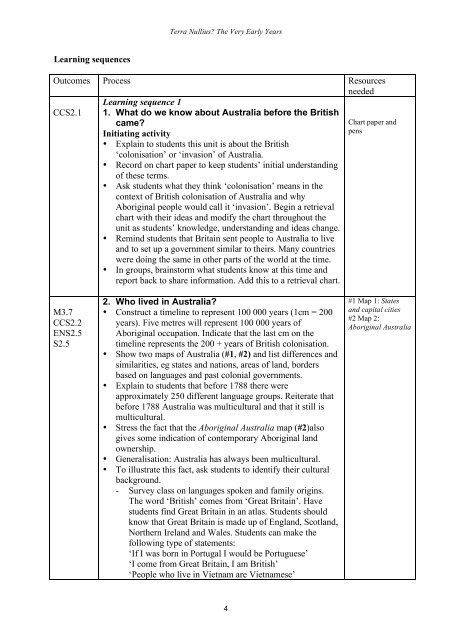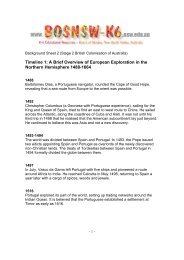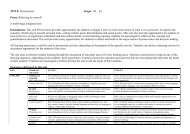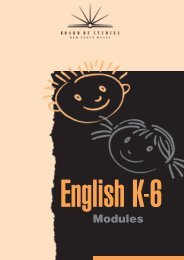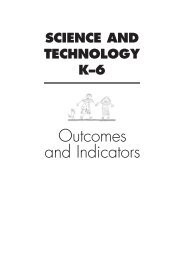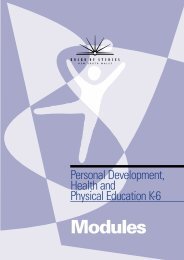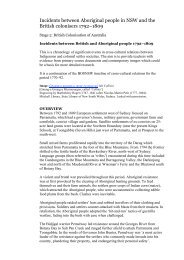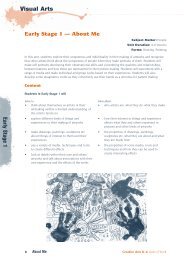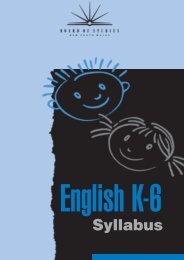Terra Nullius? The Very Early Years - K-6 Educational Resources
Terra Nullius? The Very Early Years - K-6 Educational Resources
Terra Nullius? The Very Early Years - K-6 Educational Resources
You also want an ePaper? Increase the reach of your titles
YUMPU automatically turns print PDFs into web optimized ePapers that Google loves.
Learning sequences<br />
<strong>Terra</strong> <strong>Nullius</strong>? <strong>The</strong> <strong>Very</strong> <strong>Early</strong> <strong>Years</strong><br />
Outcomes Process<br />
Learning sequence 1<br />
<strong>Resources</strong><br />
needed<br />
CCS2.1 1. What do we know about Australia before the British<br />
came?<br />
Initiating activity<br />
• Explain to students this unit is about the British<br />
‘colonisation’ or ‘invasion’ of Australia.<br />
• Record on chart paper to keep students’ initial understanding<br />
of these terms.<br />
• Ask students what they think ‘colonisation’ means in the<br />
context of British colonisation of Australia and why<br />
Aboriginal people would call it ‘invasion’. Begin a retrieval<br />
chart with their ideas and modify the chart throughout the<br />
unit as students’ knowledge, understanding and ideas change.<br />
• Remind students that Britain sent people to Australia to live<br />
and to set up a government similar to theirs. Many countries<br />
were doing the same in other parts of the world at the time.<br />
• In groups, brainstorm what students know at this time and<br />
report back to share information. Add this to a retrieval chart.<br />
M3.7<br />
CCS2.2<br />
ENS2.5<br />
S2.5<br />
2. Who lived in Australia?<br />
• Construct a timeline to represent 100 000 years (1cm = 200<br />
years). Five metres will represent 100 000 years of<br />
Aboriginal occupation. Indicate that the last cm on the<br />
timeline represents the 200 + years of British colonisation.<br />
• Show two maps of Australia (#1, #2) and list differences and<br />
similarities, eg states and nations, areas of land, borders<br />
based on languages and past colonial governments.<br />
• Explain to students that before 1788 there were<br />
approximately 250 different language groups. Reiterate that<br />
before 1788 Australia was multicultural and that it still is<br />
multicultural.<br />
• Stress the fact that the Aboriginal Australia map (#2)also<br />
gives some indication of contemporary Aboriginal land<br />
ownership.<br />
• Generalisation: Australia has always been multicultural.<br />
• To illustrate this fact, ask students to identify their cultural<br />
background.<br />
- Survey class on languages spoken and family origins.<br />
<strong>The</strong> word ‘British’ comes from ‘Great Britain’. Have<br />
students find Great Britain in an atlas. Students should<br />
know that Great Britain is made up of England, Scotland,<br />
Northern Ireland and Wales. Students can make the<br />
following type of statements:<br />
‘If I was born in Portugal I would be Portuguese’<br />
‘I come from Great Britain, I am British’<br />
‘People who live in Vietnam are Vietnamese’<br />
4<br />
Chart paper and<br />
pens<br />
#1 Map 1: States<br />
and capital cities<br />
#2 Map 2:<br />
Aboriginal Australia


